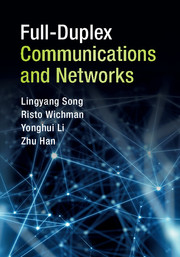Book contents
- Frontmatter
- Dedication
- Contents
- Preface
- 1 Basics of Communication Systems
- 2 Signal Processing and Theoretical Limits
- 3 Full-Duplex System Hardware Implementation
- 4 Full-Duplex MIMO Communications
- 5 Full-Duplex OFDMA Communications
- 6 Full-Duplex Heterogeneous Networks
- 7 Full-Duplex Cooperative Networks
- 8 Full-Duplex Cognitive Radio Networks
- 9 Full-Duplex Random Access Networks
- References
- Index
1 - Basics of Communication Systems
Published online by Cambridge University Press: 16 March 2017
- Frontmatter
- Dedication
- Contents
- Preface
- 1 Basics of Communication Systems
- 2 Signal Processing and Theoretical Limits
- 3 Full-Duplex System Hardware Implementation
- 4 Full-Duplex MIMO Communications
- 5 Full-Duplex OFDMA Communications
- 6 Full-Duplex Heterogeneous Networks
- 7 Full-Duplex Cooperative Networks
- 8 Full-Duplex Cognitive Radio Networks
- 9 Full-Duplex Random Access Networks
- References
- Index
Summary
A wireless network refers to a telecommunications network in which interconnections between nodes are implemented without the use of wires. Wireless networks have experienced unprecedented growth over the past few decades, and they are expected to continue to evolve in the future. Seamless mobility and coverage ensure that various types of wireless connections can be made anytime, anywhere. In this chapter, we first introduce some advanced types of wireless communication techniques. Next, we study the heterogeneous wireless networks, and finally we provide the reader with some necessary background on the state of the art in full-duplex development.
Advanced Wireless Communication Technology
In this section, we discuss some of the current state of the art in wireless technologies related to D2D communications.
OFDM/OFDMA Technology
Orthogonal Frequency-Division Multiplexing (OFDM) is a technique for transmitting multiple digital signals simultaneously over a large number of orthogonal subcarriers. Based on the fast Fourier transform algorithm to generate and detect the signal, data transmission can be performed over a large number of carriers that are spaced apart at precise frequencies. The frequencies (or tones) are orthogonal to each other. Therefore, the spacing between the subcarriers can be reduced and hence high spectral efficiency can be achieved. OFDM transmission is also resilient to interference and multipath distortion which causes Inter-Symbol Interference (ISI).
OFDM transmitter and receiver block diagrams are shown in Fig. 1.1 and Fig. 1.2, respectively. s[n] is a serial stream of binary digits to transmit. After serial-to-parallel conversion, the data is split into N streams. Each stream is then coded to X0, … XN−1 with possibly different modulation methods (such as PSK and QAM) depending on the subchannel condition. An inverse FFT is computed on each set of symbols, giving a set of complex time-domain samples. These samples are then quadrature-mixed to passband in the standard way: the real and imaginary components are first converted to the analog domain using digital-to-analog Converters (DACs); the analog signals are then used to modulate cosine and sine waves, respectively, at the carrier frequency, fc. These signals are then summed to yield the transmission signal, s(t). The receiver picks up the signal r(t), which is s(t) transmitted through radio channels and contaminated by noise. Then r(t) is quadrature-mixed down to baseband using cosine and sine waves at the carrier frequency.
- Type
- Chapter
- Information
- Full-Duplex Communications and Networks , pp. 1 - 49Publisher: Cambridge University PressPrint publication year: 2017



